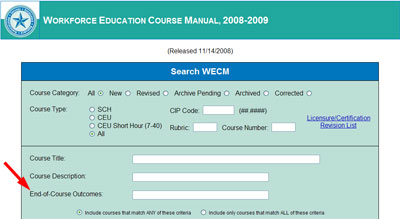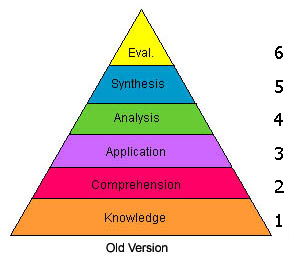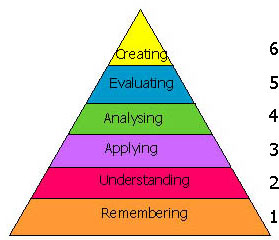![]() R. Craig Collins >Common> Training Home Page> CIA definitions
R. Craig Collins >Common> Training Home Page> CIA definitions
CIA: Definitions © R. Craig Collins, 2009
| CIA: Curriculum-Instruction-Assessment | to Bloom's Taxonomy | to CIA Overview Quiz |
Curriculum
What the state says the outcomes should be; End-of-course Outcomes=Terminal Objectives

Instruction
How faculty guide their class toward the final outcomes, using enabling objectives.
There are two primary types of learning objectives we will be working with:
Terminal Objective: the outcome of the final product. What should the student "look like" when the course is complete?
What should they be able to do?
Enabling Objective: Defines the steps to accomplishing the terminal objective.
How is the terminal objective going to be accomplished?
Instruction is often best developed around REACT (see also Joint the CIA)
Relate, show them how they already know a lot about related topics
Experience, a guided tour where faculty and class go through the new learning together
Apply, homework... practicing on the new learning
Cooperate is a great way to leverage student-lead teaching to provide multiple points of view and to hone a topic
Transfer, can they apply the learning to a new and novel situation? This is what proves learning occurred.
Assessment
Types
Assessments can be classified in many different ways.
The most important distinctions are:
Formative and Summative Assessment
Summative assessment is generally carried out at the end of a group of related tasks, or at the end of a course. In an educational setting, summative assessments are typically thought of as tests, and used to assign students a grade.
Formative assessment is generally carried out throughout a course, and is used to aid learning. In an educational setting, formative assessment might be the teacher or the learner providing feedback on a student's work, and would not necessarily be used for grading purposes.
Formative assessments help identify class trouble spots, so Instruction can be revised.
TC uses a form of Formative assessment called CAT (Classroom Assessment Technique)
 |
 New version |
Action verbs to illustrate level of learning: 2. Comprehension : Conclude, Demonstrate, Discuss, Explain, Generalize, Identify, Illustrate, Interpret, Paraphrase, Predict, Report, Restate, Review, Summarize, Tell 3. Application: Apply, Change, Choose, Compute, Dramatize, Interview, Prepare, Produce, Role-play, Select, Show, Transfer, Use 4. Analysis: Analyze, Characterize, Classify, Compare, Contrast, Debate, Deduce, Diagram, Differentiate, Discriminate, Distinguish, Examine, Outline, Relate, Research, Separate 5. Synthesis: compose, construct, create, design, develop, integrate, invent, make, organize, perform, plan, produce, propose, rewrite 6. Evaluation :Appraise, Argue, Assess, Choose, Conclude, Critic, Decide, Evaluate, Judge, Justify, Predict, Prioritize, Prove, Rank, Rate, Select |
The new terms are defined as:
(Anderson & Krathwohl, 2001, pp. 67-68) |
To be taken after reviewing the above document, and Join the CIA, Overview (pdf)
Name: Employee ID number
1. Most faculty have advanced degrees in their teaching discipline, NOT in teaching, meaning some faculty might be able to use a little help designing syllabi, unit plans, and lesson plans.
True or False
2. What does CIA stand for?
Curriculum is ____________________________
Instruction is ____________________________
Assessment is ____________________________
3. One key to designing instruction is to base it on outcomes, “what should the student be able to do?”
A good way to construct outcomes (aka objectives) is to use Bloom’s ______________.
4. When constructing outcomes, you should avoid lower level Bloom’s items, such as Knowledge and Comprehension.
True or False
5. What are the higher level learning items in Bloom’s?
______________________ , and example verb from this level is ______________________
______________________ , and example verb from this level is ______________________
______________________ , and example verb from this level is ______________________
______________________ , and example verb from this level is ______________________
6. The react model is a series of steps that can be used during instruction.
R is for Relate; illustrating how this is similar to what they already know
E is for __________________________
A is for __________________________
C is for __________________________
T is for Transfer, where they demonstrate what they have learned by applying the skill to a new situation
7. Summative assessment are used to measure learning at some point in time, say the end of a course.
True or False
8. Formative assessments gauge progress during the learning process. This gives faculty the opportunity to follow up on material that is not clear to students, and perhaps to update lecture material for the next time it is used. This constant process of assessment improves instruction, to better meet the outcomes of the Curriculum.
CAT (Classroom Assessment Technique) is an example of Formative assessments.
True or False
9. The best results for formative assessment come from ________________ assessments, so the students do not fear reprisal for being honest.
True or False
10. Grading can be difficult, but rubrics can help you standardize grading by determining in advance what you are looking for, and how important that item is.
True or False
Note: This is just the overview; future workshops will include additional information on all of these topics.